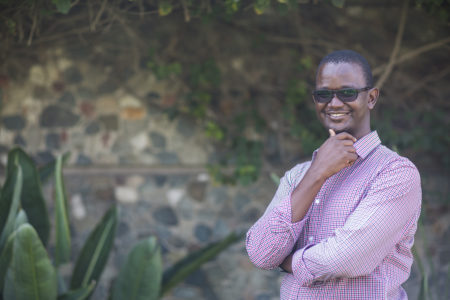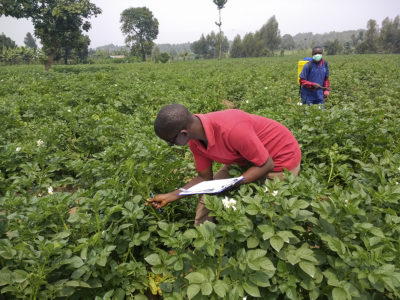
Joshua Okonya is a Uganda based research associate specializing in crop protection. He shares with us how he is putting farmers at the heart of his work on Integrated Pest Management (IPM).
What first motivated you to begin work on Integrated Pest Management?
I grew up in a poor family of eight siblings with a single mother in a rural village of Katuugo, Nakasongola district, Uganda. We’d grow cassava, sweetpotato and beans on about an acre of rented land. In Uganda, most farmers depend on rain-fed agriculture and so did my family. Subsistence farmers in our village did not normally store their crop harvest for more than one cropping season, at the most a year. The crops we planted are what we ate during that season. I think it was in the 90s when there was an outbreak of cassava mosaic disease, which cleared all cassava fields. There was no solution to this disease. Since cassava is a staple crop in Uganda, hunger was widespread not only in my village but the entire country. It meant sleeping without eating three meals in a day sometimes even cutting back to only one meal. I wanted to understand what was happening and vowed that I would one day study agriculture.
How does IPM contribute to food security?
The thing with pests is that they don’t discriminate. Irrespective of how good the seed a farmer is using, or the amount of inputs, when a pest comes it can cause complete crop loss. We saw this happen in 2005 during a banana bacterial wilt outbreak and we’re seeing it now with the Fall Army Worm . Integrated Pest Management has the ability to not only increase food security it can also reduce poverty levels. When farmers are able to preserve their harvests and sell the surplus it means extra cash income for the family.

What are some of the pest management methods farmers are currently using?
Farmers often use pesticides to eliminate threats. This can be costly and we’ve found that many times farmers are not well informed on safe-chemical use and don’t protect themselves. Educational levels vary. Some of the farmers we work with aren’t literate. It requires really understanding the challenges and level of knowledge of each farmer in order to develop tools that will work for them. Our goal is to feed the farmers with nutritious foods and not chemicals.
Your research really takes into account farmer behaviors and their understanding of pests and diseases. Why is this important?
You always have to put a human face to your research. You can’t just go in the lab and engineer something without understanding what the farmers want, what they need and how to move forward. Designing an IPM approach or package, needs to fit into their culture and farming system. To do that you need to see how they live, what resources are available and how crop management roles are shared among household members. For example with pesticides, we can’t simply come in and prescribe standard practices for proper handling of pesticides. We can’t say, place your pesticide containers in storage, some of them don’t have storage and need to keep the pesticides in the house where they live. We need to think about their reality and how we can adapt our approaches of minimizing pesticide poisoning to their lifestyle. For instance, we can advise them to place pesticides in a cupboard away from food and where the kids can’t reach and to not re-use a pesticide container to store food, water or salt. As researchers we really need to understand the culture and socio-economic background we are working in before recommending an approach. Otherwise you end up not speaking the same language as the farmer and may not get the desired results and impact.

What role does gender play in pest management? How does applying a gender lens deepen the impact of your work?
If your aim is to achieve food security you need to know the factors affecting food security. You will not know this without going out to talk to the smallholder farmers. Even when visiting households, you have to be aware of the cultural dynamics. In many patriarchal societies women are side-lined. The head of the household, the husband, will receive an extension officer or researcher visiting a family, and in most cases he will be the only point of contact. This gives researchers a very false impression. Women are the ones who are mainly monitoring pests and diseases during storage, because they spend more time at the home and observe. So, if you’re setting up traps to monitor seasonal variation in insect populations or diseases, and you come and talk to the man, you’ll go away without getting adequate and in-depth knowledge. When it comes to pesticides, mainly the men buy them and apply them, so it’s okay if you talk to a man about chemical application.
What challenges do farmers face in managing pests?
There are a number of challenges that farmers meet when managing pests and diseases. One of them is lack of pest resistant varieties because, for example no variety is currently resistant to the African sweetpotato weevil (Cylas species). Lack of adequate pest monitoring throughout the season can lead to complete crop failure, especially during a prolonged dry season. It is important to engage farmers and get to know at which stage an intervention is needed. Some farmers can’t read pesticide labels. We need to help them understand the effects of chemical pesticides and how to properly handle them. Extension training of farmers is really important. Many farmers don’t know the names of the pests or diseases affecting their crops. If asked, “what is affecting your sweetpotato” they’ll answer, “oooh, it’s the sun,” when it’s really the sweetpotato weevil. Since that pest attacks during the dry season, the farmer will associate a long dry season with sweetpotato damage and they blame it on the sun. As a scientist looking to understand the challenges farmers face you have to dig deep. With the proper training and cultural understanding a scientist is able to ask the right questions to get the correct diagnosis of what the problem is.
What IPM support has CIP and the CGIAR Research Program on Roots, Tubers and Bananas (RTB) helped to develop?
We give extension training to farmers on more than one method to manage pests, including how to use cultural practices, which are low-cost and require few resources. We encourage the use of virus free seed. CIP has also developed pheromone traps— a type of attract-and-kill technology for use in potato stores. An insecticide is mixed with a pheromone that attracts the male species. These males think it is a female, so when they come looking to mate they come in contact with the pheromone mixed with an insecticide and die. By studying the biology of the pests, CIP has also published a Pest Risk Atlas for Africa which policymakers can use mainly for planning purposes to understand the potential risk of insect pests in the face of climate change.
Why is an integrated crop approach important?
No smallholder farmer in Uganda, Rwanda, or Burundi specializes in only one crop. A sweetpotato farmer will also grow banana, cassava, potato, and beans. RTB takes a holistic view of these very crops, which all face pest problems. Some invasive pests such as the fall armyworm are polyphagous and will cause economic losses not only on the primary host (maize) but also on other crops including sweetpotato. So, it’s paramount that CGIAR continues to support programs that are cross-crop and cross-center. When research centers work together we are able to capture more information while using fewer resources. The more we work together across all these crops we’ll really improve food security for the farmers and improve their livelihoods.
For more on Okonya’s research
Okonya, J. S., Syndikus, K., & Kroschel, J. (2013). Farmers’ perception of and coping strategies to climate change: Evidence from six agro-ecological zones of Uganda. Journal of Agricultural Science, 5(8), 252.
Okonya, J. S., & Kroschel, J. (2015). A cross-sectional study of pesticide use and knowledge of smallholder potato farmers in Uganda. BioMed Research International, 2015.
Legg, J., Okonya, J. & Coyne, D.(2017). Integrated pest management of root and tuber crops
in the tropics. In C. Rapisarda and GEM Cocuzza, Integrated pest management in tropical
regions. Wallingford, UK: CABI Publishing,(p. 90-112).
